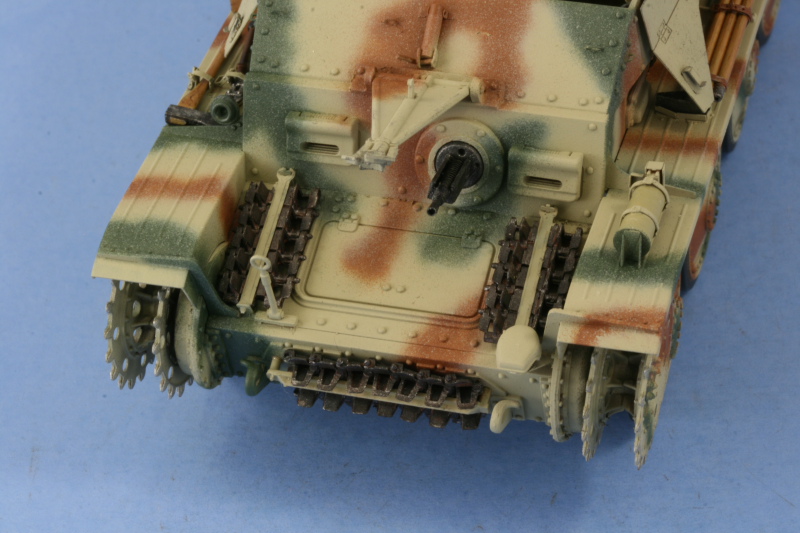
As you can see above, the brush is not in pristine condition and that's just fine for this use. The brush is dipped into the paint and then the paint blotted off just like you would for dry-brushing but instead of dry-brushing, I used a stabbing/stippling motion to randomly add the desired level of scuffing.

Some areas come out heavier than others using this approach and to blend things back in a bit and not make it so harsh, I repeated the stippling but with the 50-50 Light Gray/Dunkelgelb base coat mix.

The end result provides a foundation for further weathering which will come later in the form of pin washes and pigments. I tried to use some logic and deliberately added more wear to the loader's side vs. the gunner since it would tend to get more foot-traffic. The spent shell basket also got some wear added and a couple of spare shells will reside there before it's all said and done.

Continuing on with the details, I turned next to the gun shield equipment. The gas masks were pained with a mix of Panzer Schwarzgrau and Russian Armor Green more or less in a 50-50 mix and the straps detailed with Leather. The periscopes were painted with Italian Dark Brown for their Bakelite surfaces and the lenses painted with Silver followed by a treatment of Tamiya Clear Smoke. The various surfaces received the same wear-and-tear treatment as the fighting compartment.

The gun itself also received some detail attention. Aside from the wear-and-tear, the breech block and shell loading area were painted with Silver and the recoil tray tops dry-brushed with Steel for the bare-metal look. The optical and open sights were painted with Non-buffing Metalizer Gunmetal and lightly dry-brushed with Steel. The wood handles on the elevation and traverse wheels were painted with my own special "wood" color and then dusted with burnt umber artist pastels.

The gun shield and gun were then joined to make things permanent.

Turning to the rear hull, the muffler/exhaust was base coated with Non-Buffing Metalizer Gunmetal and then given 2 successive washes of highly thinned Rust. Once that had dried, I dry brushed Burnt Umber to tone down some of the Rust effects a bit. The rear Notek lenses were painted with Tamiya Clear Green and the straps on the right side tray detailed with Leather and dry brushed with lightened Dunkelgelb and Gunmetal to give them some highlights. The details on the external fire extinguisher were also added and the FE repainted with a darker shade of Dunkelgelb/Light Gray to provide a little variety.

Moving around the vehicle, the left side received a suitably weathered folded over crew seat. The antenna base mount was painted with Gunmetal to simulate its rubber look and the sledge hammer and unique cleaning rods for the Pak 36(r) installed. I added the Eduard PE leather straps and painted them with Leather and detailed them the same way as the other straps. The lower hull was pre-weathered as well and the springs base coated with Non-Buffing Metalizer Gunmental, dry brushed with Steel, and then given a light wash of Rust. The hull MG was also painted at this time and the gun sight added, it too was base coated with the metalizer Gunmetal and then lightly dry brushed with Steel.

The right hand side had the wire cutters repainted since it was suffering from some severe over spray from the camo application. The crew seat was also added and the jack block and the axe installed in their proper positions.

Next up will be dealing with the hull front in terms of the spare track runs and holders and then installing the running gear and working on the main tracks.





































